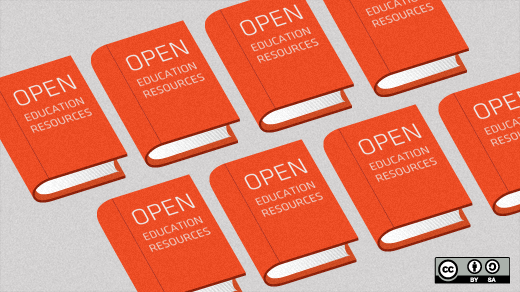At the school district where I am the director of information technology, over 90% of our information systems have been transitioned to open source software. Ubuntu is the server operating systems at the district office and schools, while the Ubuntu desktop is deployed for students, teachers, and administration through the use of diskless clients.
As a result, students and teachers use primarily open source programs which include LibreOffice, Scribus, the Gimp, and Inkscape, to name a very few. We are able to centrally control over 2300 workstations at 16 schools and keep software much more current than many districts attempting to maintain commercial software packages. We have achieved significant energy savings, over 70% on our clients, and greatly reduced licensing costs.
I am frequently involved in discussions that revolve around bringing innovative to education which of course involves a technological aspect. And just as frequently, the requested technology includes utilizing popular commercial software, iDevices, and so forth. Although many teachers have embraced and see the potential of open source-based software, I occasionally hear people indicating how our districts use of open source software somehow diminishes the learning experience of our students. This is particularly curious when there is so much discussion about changing our education system to become more personalized for each student, improve student achievement, incorporate flexibility and choice, while bringing higher standards and empowering learning through technology.
There is no doubt that some open source programs are not as polished or mature as some commercial software but this has to be weighed against the plethora of freely available resources for K-12 and our ability to prepare our students for post-secondary, business and life. There are obvious advantages and disadvantages for both.
Open source advantages
Open source provides several significant benefits to K-12 including:
- reduction of licensing costs and overall cost of ownership
- provision of education tools anytime, anywhere
- customization based on the needs we recognize
- administration based on our community and expertise
- utilization of energy efficient, low-cost, sustainable hardware
Open source as a driver for innovation
Ironically, perhaps the greatest argument in favour of using open source software is increase innovation and collaboration.
The online Business Dictionary definition of innovation:
The process of translating an idea or invention into a good or service that creates value. To be called an innovation, an idea must be replicable at an economical cost and must satisfy a specific need. Innovation involves deliberate application of information, imagination and initiative in deriving greater or different values from resources, and includes all processes by which new ideas are generated and converted into useful products.
As an educational institution we are being encouraged to innovate and collaborate while supporting our students to do likewise. My thesis is: if we insist that our students utilize expensive, commercial software and hardware, we may be reducing opportunities for innovation. Commercial software has been developed for a very specific purpose: generating profit and increasing shareholder earnings. That is not to say there are not opportunities for commercial software in education, however I contend that OpenOffice or LibreOffice are excellent alternatives to commercial equivalents, for example.
Open source software, by its very nature, is the result of a communal need. A community comes together to collaborate and fill a specific demand or requirement. They share the cost of development and provide improvements to the software for no other reason than to satisfy that need. Moodle is an excellent example of this. Moodle was initially developed by Martin Dougiamas, an educator and computer scientist from Perth Australia.
From Wikipedia:
"When his university installed an early learning management system, called WebCT, he was frustrated that the software’s intellectual property restrictions prevented him from enhancing the system. This experience convinced him of the need for an open-source solution. Throughout the process of study and research for a master’s degree and Ph.D., Dougiamas began developing the set of online tools that would become Moodle."
Moodle is now the worlds leading Learning Management System and used extensively at post-secondary institutions and school districts. Our school district has successfully standardized on Moodle for both content and course management. The Kuali Foundation is another example where the post-secondary community has come together to provide solutions that commercial vendors cannot fulfill.
Who uses open source software?
Returning to the assumption that using open source in some way disadvantages our students, it is important to test that statement by modern government and corporate use. Most large organizations use open source software including governments and major corporations. As well over the past decade the impact of cloud-based social networks and services have altered the way we communicate and purchase. Factually, many of the leading social media applications and large service providers incorporate open source as the foundation of their applications. Without open source, many of these organizations and companies would not exist. Although many people are not aware, the Internet runs on open source software and we use it every day when we surf, communicate, purchase, and research on the net.
Companies such as Google, YouTube, Facebook, Twitter, LinkedIn, Amazon, eBay all have open source as the foundation for their infrastructure and cloud-based services. May of them have contributed significantly to open source projects such as Linux, Eclipse, Apache while others have spawned important projects, such as Google's Android operating system and Facebook's Open Compute project. Large hardware and service companies like IBM and Hewlett Packard contribute significant resources and financial contributions to open source projects.
If these modern, forward-thinking companies use open source, then...
There are many more examples relating to how important open source software is to business today. When we really consider the implications of this, I feel that our students who have been exposed to open source technologies will have the greatest advantage when they go through post-secondary education and apply for jobs. At our school district, we provide students with open source alternatives and associated skills and concepts which are easily transferable to commercial software applications. Do we earnestly believe that because our students are using LibreOffice this will somehow limit them from quickly adapting to MS Office or Google Docs?
Therefore, if the assumption that open source software stifles innovation is not correct, what other false assumptions have been made? Another argument I hear frequently from teachers is that if we do not expose our students to technology through the use of commercial software, students will incur a significant disadvantage when they enter post-secondary programs. It is assumed that entrance to drafting programs require the use of commercial drafting programs, or business administration students must be proficient with commercial office packages and so forth. Is this an accurate message?
Which post-secondary programs require experience with commercial software as a prerequisite?
If we were to closely analyze course and program requirements for entrance into many college and university programs, we might ask which courses require a secondary student be proficient in propriety office productivity software, commercial drafting packages, digital media software, and so forth. In actual fact, very few, if any.
Certainly not business administration or accounting, as they require math and english skills, not technical drawing/drafting for which prerequisites are hand drafting and sketching, not digital media and so forth. In British Columbia, the Ministry of Education provides standards through Prescribed Learning Outcomes, which rarely specifies specific software program that must be used for a course, however they do talk extensively about teaching skills and concepts. Of course, if our schools do teach concepts and skills and supplement with technology resources such as GNUCash for accounting, the Gimp for digital media, LibreCAD for technical drawing, and so forth, students definitely have an additional advantage—but having experience with commercial software is rarely a prerequisite for post-secondary programs or courses.
What are the unstated reasons for not wanting to use open source software in the school system?
So if the premise is correct, that open source software does not hinder students pedagogically or strategically, what might be the real reason for opposition to using it in the classroom? There are often two significant reasons that are understood but infrequently stated.
Firstly, part of a commercial software's marketing strategy often includes resources targeted to teachers—sometimes freely available or available at-a-cost. These learning resources might include lesson plans, sample documents or files, or published instructional books. There is no denying this makes a teacher's job a lot easier if a particular product comes with a lesson plan structured for that software program. There may also be training materials available to help the teacher transition to a particular software program, again as part of a commercial products marketing strategy.
Second, open source software, by its very nature, is not about marketing, but about the ability to become involved in its ongoing development as part of a community. Fundamentally, it is innovative, collaborative, and fosters community. In that regard it requires some work on the part of developers and users. This can be challenging for people who just want to use whatever software is available. Frequently learning new software can be daunting and extensive training materials are included with commercial software.
This can be a challenge for a teacher when approaching new software. Training resources, including courses, books, and so forth, can provide users with an opportunity for transition from commercial to open source alternatives. Sometimes these resources are lacking.
Can LibreOffice be used as an effective teaching tool in K-12 education? Absolutely, however having additional teaching resources would certainly make this easier. For example BlueJ is a post-secondary project that is not only a very good IDE for software development, but an excellent instructional tool for computer science. Moodle has excellent tutorials and learning resources as another example. Some open source software has gone a long way to do this but more work needs to be done to make the transition from commercial to open source software much easier for teachers.
Therefore, if we can remove possible objections to using open source software through providing associated lesson plans, sample data and/or training problems would provide a significant incentive for teachers. It may be something the individual projects may want to consider. Rather than seeing open source as some sort of diminished or disadvantaged tool set, we could see it as an enormous opportunity to truly enhance our students' future by preparing them for a rapidly changing world.







3 Comments